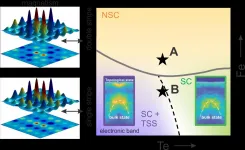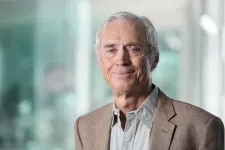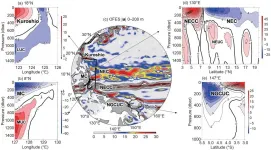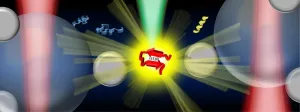(Press-News.org) UPTON, NY--Scientists characterized how the electronic states in a compound containing iron, tellurium, and selenium depend on local chemical concentrations. They discovered that superconductivity (conducting electricity without resistance), along with distinct magnetic correlations, appears when the local concentration of iron is sufficiently low; a coexisting electronic state existing only at the surface (topological surface state) arises when the concentration of tellurium is sufficiently high. Reported in Nature Materials, their findings point to the composition range necessary for topological superconductivity. Topological superconductivity could enable more robust quantum computing, which promises to deliver exponential increases in processing power.
"Quantum computing is still in its infancy, and one of the key challenges is reducing the error rate of the computations," said first author Yangmu Li, a postdoc in the Neutron Scattering Group of the Condensed Matter Physics and Materials Science (CMPMS) Division at the U.S. Department of Energy's (DOE) Brookhaven National Laboratory. "Errors arise as qubits, or quantum information bits, interact with their environment. However, unlike trapped ions or solid-state qubits such as point defects in diamond, topological superconducting qubits are intrinsically protected from part of the noise. Therefore, they could support computation less prone to errors. The question is, where can we find topological superconductivity?
In this study, the scientists narrowed the search in one compound known to host topological surface states and part of the family of iron-based superconductors. In this compound, topological and superconducting states are not distributed uniformly across the surface. Understanding what's behind these variations in electronic states and how to control them is key to enabling practical applications like topologically protected quantum computing.
From previous research, the team knew modifying the amount of iron could switch the material from a superconducting to nonsuperconducting state. For this study, physicist Gendu Gu of the CMPMS Division grew two types of large single crystals, one with slightly more iron relative to the other. The sample with the higher iron content is nonsuperconducting; the other sample is superconducting.
To understand whether the arrangement of electrons in the bulk of the material varied between the superconducting and nonsuperconducting samples, the team turned to spin-polarized neutron scattering. The Spallation Neutron Source (SNS), located at DOE's Oak Ridge National Laboratory, is home to a one-of-a-kind instrument for performing this technique.
"Neutron scattering can tell us the magnetic moments, or spins, of electrons and the atomic structure of a material," explained corresponding author, Igor Zaliznyak, a physicist in the CMPMS Division Neutron Scattering Group who led the Brookhaven team that helped design and install the instrument with collaborators at Oak Ridge. "In order to single out the magnetic properties of electrons, we polarize the neutrons using a mirror that reflects only one specific spin direction."
To their surprise, the scientists observed drastically different patterns of electron magnetic moments in the two samples. Therefore, the slight alteration in the amount of iron caused a change in electronic state.
"After seeing this dramatic change, we figured we should look at the distribution of electronic states as a function of local chemical composition," said Zaliznyak.
At Brookhaven's Center for Functional Nanomaterials (CFN), Li, with support from CFN staff members Fernando Camino and Gwen Wright, determined the chemical composition across representative smaller pieces of both sample types through energy-dispersive x-ray spectroscopy. In this technique, a sample is bombarded with electrons, and the emitted x-rays characteristic of different elements are detected. They also measured the local electrical resistance--which indicates how coherently electrons can transport charge--with microscale electrical probes. For each crystal, Li defined a small square grid (100 by 100 microns). In total, the team mapped the local composition and resistance at more than 2,000 different locations.
"Through the experiments at the CFN, we characterized the chemistry and overall conduction properties of the electrons," said Zaliznyak. "But we also need to characterize the microscopic electronic properties, or how electrons propagate in the material, whether in the bulk or on the surface. Superconductivity induced in electrons propagating on the surface can host topological objects called Majorana modes, which are in theory one of the best ways to perform quantum computations. Information on bulk and surface electronic properties can be obtained through photoemission spectroscopy."
For the photoemission spectroscopy experiments, Zaliznyak and Li reached out to Peter Johnson, leader of the CMPMS Division Electron Spectroscopy Group, and Nader Zaki, a scientific associate in Johnson's group. By measuring the energy and momentum of electrons ejected from the samples (using the same spatial grid) in response to light, they quantified the strengths of the electronic states propagating on the surface, in the bulk, and forming the superconducting state. They quantitatively fit the photoemission spectra to a model that characterizes the strengths of these states.
Then, the team mapped the electronic state strengths as a function of local composition, essentially building a phase diagram.
"This phase diagram includes the superconducting and topological phase transitions and points to where we could find a useful chemical composition for quantum computation materials," said Li. "For certain compositions, no coherent electronic states exist to develop topological superconductivity. In previous studies, people thought instrument failure or measurement error were why they weren't seeing features of topological superconductivity. Here we show that it's due to the electronic states themselves."
"When the material is close to the transition between the topological and nontopological state, you can expect fluctuations," added Zaliznyak. "For topology to arise, the electronic states need to be well-developed and coherent. So, from a technological perspective, we need to synthesize materials away from the transition line."
Next, the scientists will expand the phase diagram to explore the compositional range in the topological direction, focusing on samples with less selenium and more tellurium. They are also considering applying neutron scattering to understand an unexpected energy gap (an energy range where no electrons are allowed) opening in the topological surface state of the same compound. Johnson's group recently discovered this gap and hypothesized it was caused by surface magnetism.
INFORMATION:
This work was supported by the DOE Office of Science. The CFN and SNS are both DOE Office of Science User Facilities.
Brookhaven National Laboratory is supported by the U.S. Department of Energy's Office of Science. The Office of Science is the single largest supporter of basic research in the physical sciences in the United States and is working to address some of the most pressing challenges of our time. For more information, visit https://energy.gov/science.
Follow @BrookhavenLab on Twitter or find us on Facebook.
APRIL 28, 2021, NEW YORK - A Ludwig Cancer Research study has identified a previously unrecognized mechanism by which cancer cells of a relatively benign subtype of pancreatic tumors methodically revert--or "de-differentiate"--to a progenitor, or immature, state of cellular development to spawn highly aggressive tumors that are capable of metastasis to the liver and lymph nodes.
The study, led by Ludwig Lausanne's Douglas Hanahan and published in Cancer Discovery, a journal of the American Association for Cancer Research, also shows that engagement of the mechanism is associated with poorer outcomes in patients diagnosed with pancreatic neuroendocrine tumors (PanNETs). Further, its findings provide concrete evidence that such cellular de-differentiation, widely observed ...
April 28, 2021 - Injectable dermal fillers provide a minimally invasive approach to reduce facial lines and wrinkles while restoring volume and fullness in the face. More than 2.7 million dermal filler procedures were performed in 2019, according to the most recent statistics from the American Society of Plastic Surgeons (ASPS).
Even as the popularity of dermal fillers continues to skyrocket, plastic surgeons are still working out how to maximize their benefits for patients seeking nonsurgical facial rejuvenation. Most studies have used subjective rating systems, with little objective evidence on the outcomes achieved.
One recent study suggested that in addition to their "volumizing" effects, dermal fillers may also have variable "lifting" effects. Sebastian Cotofana, ...
Philadelphia, April 28, 2021 - Researchers from the Center for Autism Research (CAR) at Children's Hospital of Philadelphia (CHOP) found that difficulties in diagnosing toddlers with autism spectrum disorder (ASD) might be due to the dynamic nature of the disorder during child development. Children with clinical characteristics that put them on the diagnostic border of autism have an increased susceptibility to gaining or losing that diagnosis at later ages. The findings were published online by The Journal of Child Psychology and Psychiatry.
While most children diagnosed with ASD at early ages retain their diagnosis, a significant number of children have more dynamic presentations of clinical ...
Testicular cancer is the most common type of cancer to affect men between the ages of 15 and 49, and around 95% of these cases are caused by testicular germ cell tumours. Although testicular germ cell tumours typically manifest after puberty, problems in the embryonic development of germ cells can transform them into cancer cells that form tumours later in life.
In the embryo, germ cells initially have the potential to form many different cell types, a characteristic called pluripotency. Normally, germ cells lose this ability as embryonic development progresses and they become restricted to only form sex cells - sperm in males and eggs ...
LOS ANGELES - Patients with advanced colorectal cancer may be spared from a toxic side effect caused by a type of targeted therapy used to treat the cancer with the help of another drug normally used to treat melanoma, according to a study led by researchers at the UCLA Jonsson Comprehensive Cancer Center and Memorial Sloan Kettering Cancer Center.
For the past decade, epidermal growth factor receptor (EGFR) inhibitors have helped prolong the lives of patients with many advanced cancers, including cancers in the lung, head and neck, colorectal, breast, bladder and pancreas. While these targeted therapy drugs are highly effective at keeping the cancer at bay, they can cause patients to develop ...
OAK BROOK, Ill. - An automated system that uses artificial intelligence (AI) is effective at detecting a common type of wrist fracture on X-rays, according to a study published in the journal Radiology: Artificial Intelligence. Researchers said the AI-derived algorithm could help speed diagnosis and allow earlier treatment.
Scaphoid fractures are injuries to one of the small bones of the wrist that typically occur when people try to break a fall with their hands. They comprise up to 7% of all skeletal fractures. Prompt diagnosis is important, as the fracture may fail to heal properly if untreated, leading to a host of problems like arthritis and even loss of function.
Conventional X-ray is the imaging technique of choice for diagnosing scaphoid ...
Studying the violent collisions of black holes and neutron stars may soon provide a new measurement of the Universe's expansion rate, helping to resolve a long-standing dispute, suggests a new simulation study led by researchers at UCL (University College London).
Our two current best ways of estimating the Universe's rate of expansion - measuring the brightness and speed of pulsating and exploding stars, and looking at fluctuations in radiation from the early Universe - give very different answers, suggesting our theory of the Universe may be wrong.
A third type of measurement, looking at the explosions of light and ripples in the fabric of space caused ...
Under the background of global warming, the energy budget of the earth is out of balance with more than 90% of additional heat entering the ocean.
The tropical Pacific Ocean has an important influence on the global tropical climate and the climate of China, and the tropical Pacific Western Boundary Currents (WBCs) that flow through it plays an important role in the climate system. Large-scale ocean circulation redistributes ocean heat and mass and is hence one of the basic dynamic processes that shape the earth's Marine environment. The tropical Pacific WBCs system is a key part of the global ocean circulation system. ...
It is challenging to analyze proteins at low concentrations, especially for those in a mixture of various conformations such as intrinsically disordered proteins (IDPs). A research team led by Prof. HUANG Jinqing, Assistant Professor of Department of Chemistry at The Hong Kong University of Science and Technology (HKUST), has developed optical tweezers-coupled Raman spectroscopy that can directly probe the structural features of alpha-synuclein, an IDP closely linked to Parkinson's disease, at the physiological concentration by focusing on individual protein molecules.
IDPs play an important role in biological processes and many of them are associated with incurable neurodegenerative ...
Researchers from the Universities of Bristol and Surrey have found that well-fitting, three-layered cloth masks can be as effective at reducing the transmission of COVID-19 as surgical masks.
At the height of the COVID-19 pandemic, 139 countries mandated the use of face coverings in public space such as supermarkets and public transports. The World Health Organization also advises the use of face coverings and offers guidance on their effective features. Face coverings suppress the onward transmission of COVID-19 through exhalation and protect the wearer on inhalation.
In a paper published by the Physics of Fluids journal, the researchers detail how they looked at how liquid ...





